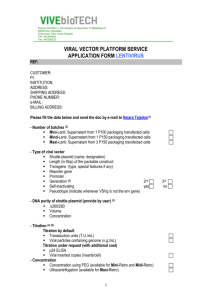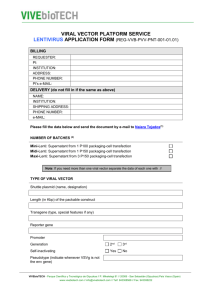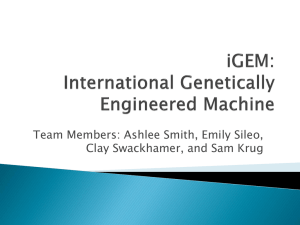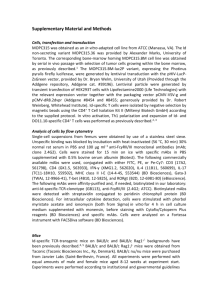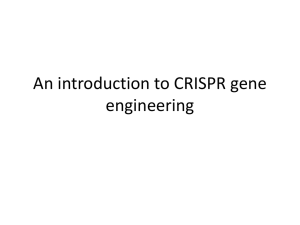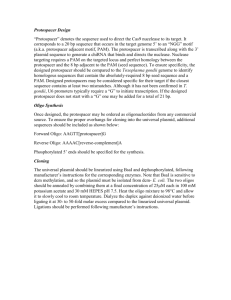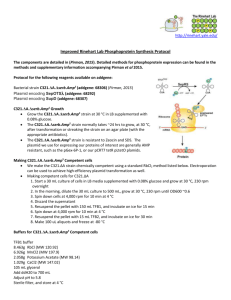file - Genome Biology
advertisement
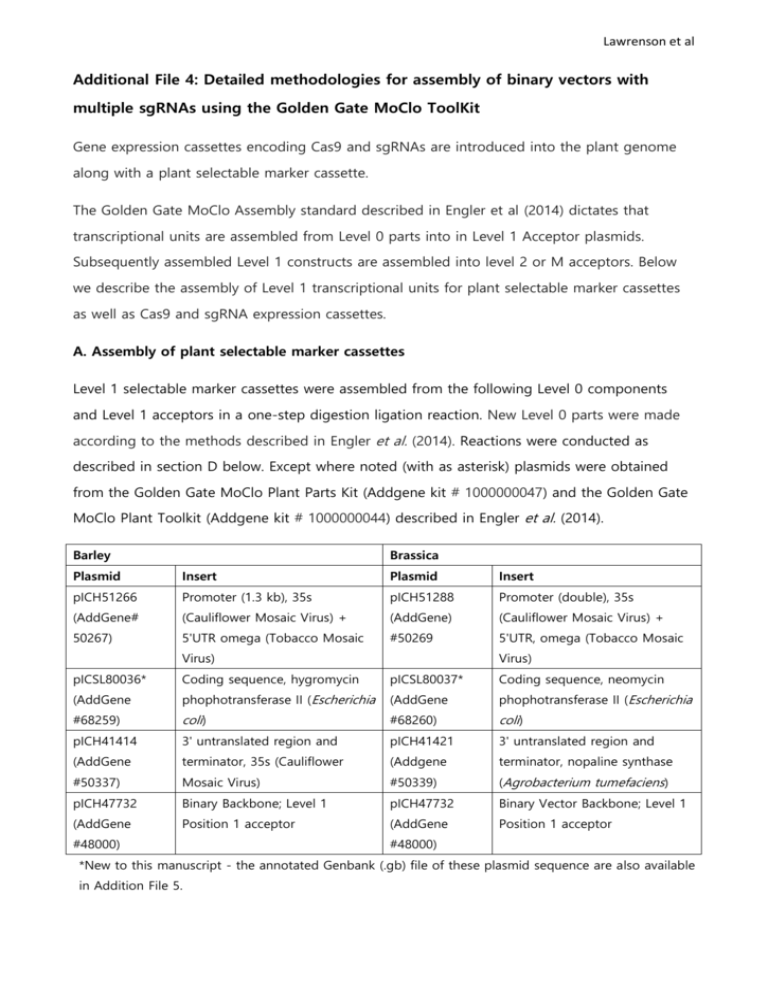
Lawrenson et al Additional File 4: Detailed methodologies for assembly of binary vectors with multiple sgRNAs using the Golden Gate MoClo ToolKit Gene expression cassettes encoding Cas9 and sgRNAs are introduced into the plant genome along with a plant selectable marker cassette. The Golden Gate MoClo Assembly standard described in Engler et al (2014) dictates that transcriptional units are assembled from Level 0 parts into in Level 1 Acceptor plasmids. Subsequently assembled Level 1 constructs are assembled into level 2 or M acceptors. Below we describe the assembly of Level 1 transcriptional units for plant selectable marker cassettes as well as Cas9 and sgRNA expression cassettes. A. Assembly of plant selectable marker cassettes Level 1 selectable marker cassettes were assembled from the following Level 0 components and Level 1 acceptors in a one-step digestion ligation reaction. New Level 0 parts were made according to the methods described in Engler et al. (2014). Reactions were conducted as described in section D below. Except where noted (with as asterisk) plasmids were obtained from the Golden Gate MoClo Plant Parts Kit (Addgene kit # 1000000047) and the Golden Gate MoClo Plant Toolkit (Addgene kit # 1000000044) described in Engler et al. (2014). Barley Brassica Plasmid Insert Plasmid Insert pICH51266 Promoter (1.3 kb), 35s pICH51288 Promoter (double), 35s (AddGene# (Cauliflower Mosaic Virus) + (AddGene) (Cauliflower Mosaic Virus) + 50267) 5'UTR omega (Tobacco Mosaic #50269 5'UTR, omega (Tobacco Mosaic Virus) Virus) pICSL80036* Coding sequence, hygromycin pICSL80037* Coding sequence, neomycin (AddGene phophotransferase II (Escherichia (AddGene phophotransferase II (Escherichia #68259) coli) #68260) coli) pICH41414 3' untranslated region and pICH41421 3' untranslated region and (AddGene terminator, 35s (Cauliflower (Addgene terminator, nopaline synthase #50337) Mosaic Virus) #50339) (Agrobacterium tumefaciens) pICH47732 Binary Backbone; Level 1 pICH47732 Binary Vector Backbone; Level 1 (AddGene Position 1 acceptor (AddGene Position 1 acceptor #48000) #48000) *New to this manuscript - the annotated Genbank (.gb) file of these plasmid sequence are also available in Addition File 5. Lawrenson et al B. Assembly of Cas9 expression cassettes Level 1 Cas9 expression cassettes were assembled from the following Level 0 components and Level 1 acceptors in a one-step digestion ligation reaction. New Level 0 parts were made according to the methods described in Engler et al. (2014). Reactions were conducted as described in section D below. Except where noted (with as asterisk) plasmids were obtained from the Golden Gate MoClo Plant Parts Kit (Addgene kit # 1000000047) and the Golden Gate MoClo Plant Toolkit (Addgene kit # 1000000044) described in Engler et al. (2014). Barley Brassica Plasmid Insert Plasmid Insert pICSL12009* Promoter and 5' untranslated pICSL12006 Promoter and 5' (AddGene #68257) region, Ubiquitin (Zea mays) (Addgene #50270) untranslated region, Cassava Vein Mosaic Virus pICH41308 Cas9 (Streptococcus pICH41308 Cas9 (Streptococcus (Addgene#49770) pyogenes) codon optimised (Addgene#49770) pyogenes) codon for expression in humans** optimised for expression in humans** pICH41421 3' untranslated region and pICH41414 3' untranslated region and (Addgene #50339) terminator, nopaline synthase (AddGene #50337) terminator, 35s (Cauliflower (Agrobacterium tumefaciens) Mosaic Virus) pICH47742 Binary Vector Backbone; Level pICH47742 Binary Vector Backbone; (AddGene #47742) 1 Position 2 acceptor (AddGene #47742) Level 1 Position 2 acceptor *New to this manuscript - the annotated Genbank (.gb) files of these plasmid sequence are also available in Addition File 5. **Kindly received from Sophien Kamoun (Nekrasov V, Staskawicz B, Weigel D, Jones JD, Kamoun S: Targeted mutagenesis in the model plant Nicotiana benthamiana using Cas9 RNA-guided endonuclease. Nat Biotechnol 2013;31:691–3). C. Assembly of sgRNA expression cassettes Target sequences were selected from confirmed genomic sequences conforming to 5' GNNNN NNNNN NNNNN NNNNN NGG 3' The target sequence was integrated into a double stranded DNA molecule ready for assembly with a U6 promoter in a Level 1 Golden Gate reaction using a 5' tailed oligonucleotide tailed primer to amplify the sgRNA from an existing sgRNA containing plasmid (Addgene#46966 a gift from Sophien Kamoun). Lawrenson et al For barley the forward primers were as follows: tgtggtctca CTTG NNNN NNNNN NNNNN NNNNN gttttagagctagaaatagcaag (The BsaI recognition site is in blue; the four base pair overhang produced by digestion with BsaI is in underlined capitals – this fuses to the last four base pairs of the AtU6-26 promoter in plasmid pICSL90002; the 20 bp target sequence is in red; the portion of the oligonucleotide that anneals to the sgRNA template in in bold italics) For brassica the forward primers were as follows: tgtggtctca ATTG NNNN NNNNN NNNNN NNNNN gttttagagctagaaatagcaag (The BsaI recognition site is in blue; the four base pair overhang produced by digestion with BsaI is in underlined capitals – this fuses to the last four base pairs of the AtU6-26 promoter in plasmid pICSL90002; the 20 bp target sequence is in red; the portion of the oligonucleotide that anneals to the sgRNA template in in bold italics) Lawrenson et al The following reverse primer was used for both species: tgtggtctca AGCG taatgccaactttgtac (The BsaI recognition site is in blue; the four base pair overhang produced by digestion with BsaI is in underlined capitals – this fused to the Level 1 acceptor plasmid; the portion of the oligonucleotide that anneals to the sgRNA template in in bold italics This was done using Phusion DNA polymerase (NEB) following the manufacturer’s instructions. This produced the following PCR amplicon: tgtggtctcaA/CTTGNNNNNNNNNNNNNNNNNNNGTTTTAGAGCTAGAAATAGCAAGTTAAAATAAG GCTAGTCCGTTATCAACTTGAAAAAGTGGCACCGAGTCGGTGCTTTTTTTCTAGACCCAGCTTTCTTGTA CAAAGTTGGCATTACGCTtgagaccaca Amplicons were verified by agarose gel electrophoresis from which they were subsequently cut and purified using a Qiaquick gel extraction kit (Qiagen). After quantification an appropriate amount of DNA was used in a Level 1 assembly reaction with the following plasmids: Barley Brassica Plasmid Insert Plasmid Insert pICSL9003* Promoter, U6 (Triticum pICSL90002* Promoter, U6-26 (AddGene #68262) aestivum) (AddGene #68261) (Arabidopsis thaliana) n/a PCR amplicon from sgRNA n/a PCR amplicons from template (amplified from sgRNA PCR template Addgene#46966 with (amplified from primers described above) Addgene#46966 with primers described above) pICH47751 Level 1, position 3 acceptor (AddGene #48002) pICH47751 Level 1, position 3 (AddGene #48002) acceptor pICH47761 Level 1, position 4 (AddGene #48003) acceptor *New to this manuscript - the annotated Genbank (.gb) files of these plasmid sequence are also available in Addition File 5. D. Protocol for assembly of Level 1 transcriptional units Level 1 assembly reactions contained 100–200 ng of the Level 1 acceptor plasmid as well as Level 0 plasmids or sgRNA amplicon such that inserts to be included in the acceptor backbone Lawrenson et al were at a 2:1 molar ratio to the acceptor. The reaction mix included 10 units of BsaI (NEB), 2 L of 10X BSA, 400 units of T4 DNA ligase (NEB) and 2 L of T4 ligase buffer (provided with T4 ligase). Reaction volumes were made up to 20 L using sterile distilled water. Reactions were incubated in a thermocycler as follows: 26 cycles of 37 °C for 3 min/16 °C for 4 min followed by 50 °C for 5 min and finally 80 °C for 5 min. A total of 2 L of each reaction was immediately transformed into chemically competent E. coli cells (Invitrogen). Cells were spread on LB agar plates containing 100 mg/L carbenicillin (Melford), 25 mg/L IPTG (Melford) and 40 mg/L Xgal (Melford). White colonies were selected and the fidelity of the clone confirmed by restriction digest analysis and Sanger sequencing. Lawrenson et al E. Assembly of Level M binary vectors with multiple sgRNAs The level 1 constructs assembled above were combined into Level M acceptor plasmids to make the final binary vectors delivered to plants (Fig. 2). The following Level 1 constructs, endlinkers and Level M acceptors were used. Except where noted (with as asterisk) plasmids were obtained from the Golden Gate MoClo Plant Toolkit (Addgene kit # 1000000044) described in Engler et al. (2014). Barley Brassica Plasmid Insert Plasmid Insert pICSL11059* Barley plant selection pICSL11055* Brassica plant selection (AddGene #68263) cassette (see above) (AddGene #68252) cassette pICSL11056* Barley Cas9 cassette pICSL11060* Brassica Cas9 cassette (AddGene #68258) (AddGene #68264) pICSL11057* Barley sgRNA cassette pICSL11061* Brassica sgRNA cassette 1 (AddGene #68253) targeting PM19_1 (AddGene #68255) targeting BolC.GA4a pICSL11058* Barley sgRNA cassette pICSL11062* Brassica sgRNA cassette 2 (AddGene #68254) targeting PM19_3 (AddGene #68256) targeting BolC.GA4a pICH50892 Position 3 end linker pICH50900 Position 4 end linker (AddGene #48046) (AddGene #48047) pAGM8031 Binary Vector Backbone; pAGM8031 Binary Vector Backbone; (AddGene #48037) Level M acceptor (Addgene #48037) Level M acceptor *New to this manuscript - The annotated Genbank (.gb) files of these plasmid sequence are also available in Additional File 5. Level M assembly reactions contained 100–200 ng of the Level M acceptor plasmid as well as Level 1 plasmids such that inserts to be included in the acceptor backbone were at a 2:1 molar ratio to the acceptor. The reaction mix included 20 units of BpiI ThermoFisher), 2 L of 10X BSA, 400 units of T4 DNA ligase (NEB) and 2 L of T4 ligase buffer (provided with T4 ligase). Reaction volumes were made up to 20 L using sterile distilled water. Reactions were incubated in a thermocycler as follows: 26 cycles of 37 °C for 3 min/16 °C for 4 min followed by 50 °C for 5 min and finally 80 °C for 5 min. A total of 2 L of each reaction was immediately transformed into chemically competent E. coli cells (Invitrogen). Cells were spread on LB agar plates containing 100 mg/L Spectinomycin (Sigma), 25 mg/L IPTG (Melford) and 40 mg/L Xgal (Melford). White colonies were selected and the fidelity of the clone confirmed by restriction digest analysis and Sanger sequencing.
